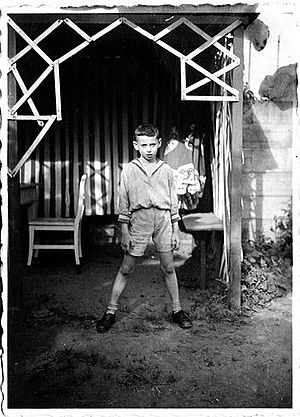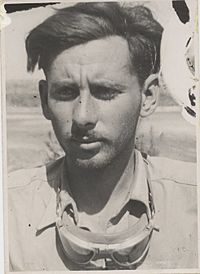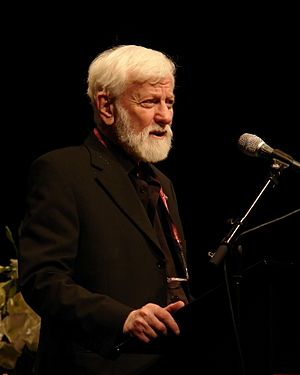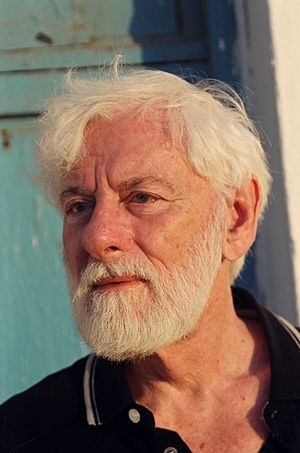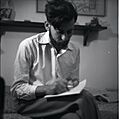Uri Avnery facts for kids
Quick facts for kids
Uri Avnery
|
|
|---|---|
| אורי אבנרי | |

Avnery in 1965
|
|
| Faction represented in the Knesset | |
| 1965–1974 | Meri |
| 1977–1981 | Left Camp of Israel |
| Personal details | |
| Born | 10 September 1923 Beckum, Germany |
| Died | 20 August 2018 (aged 94) Tel Aviv, Israel |
Uri Avnery (Hebrew: אורי אבנרי, also spelled Uri Avneri; born September 10, 1923 – died August 20, 2018) was an Israeli writer, journalist, politician, and activist. He started the Gush Shalom peace movement. As a teenager, he was part of the Irgun, a Zionist group. He also fought in the 1948 Palestine war.
Avnery served two terms in the Knesset, Israel's parliament, from 1965 to 1974 and from 1979 to 1981. He also owned and edited the news magazine HaOlam HaZeh from 1950 until 1993.
He became well-known for crossing battle lines during the Siege of Beirut in 1982. There, he met Yasser Arafat, the Palestinian leader. This was the first time an Israeli met Arafat. Avnery wrote several books about the Israeli–Palestinian conflict. These include 1948: A Soldier's Tale and My Friend, the Enemy.
He received the Right Livelihood Award in 2001. This award is sometimes called the Alternative Nobel Prize. He also received the Carl von Ossietzky Medal in 2008.
Contents
Uri Avnery's Early Life and Education
Uri Avnery was born in Beckum, Germany, in 1923. His birth name was Helmut Ostermann. He was the youngest of four children. His family was a well-known German Jewish family. His father was a private banker.
He grew up in Hanover, Germany. His family moved to Mandatory Palestine in November 1933. They left Germany after Adolf Hitler came to power. All their relatives who stayed in Germany died in the Holocaust.
Avnery went to school in Nahalal and Tel Aviv. He left school at age 14 after 7th grade to help his parents. He worked as a clerk for a lawyer for about five years.
Joining the Irgun Group
In 1938, Avnery joined the Irgun. This was a Zionist paramilitary group. He joined after a man named Shlomo Ben-Yosef was executed by the British. Avnery was too young for some of the group's actions. He changed his last name to Avnery. This honored his brother, who died serving in the British Army in 1941.
When he was 16, Second World War began. This made him interested in military strategy. He read many books on the topic.
He left the Irgun in 1942. He did not like their methods, especially using violence. He stopped supporting Zionism early on. However, he remained a nationalist. He believed that the goal of Zionism was achieved when the State of Israel was created in 1948.
In 1947, Avnery started his own small group called Eretz Yisrael HaTze'ira. They published a journal called Ma'avak ("Struggle").
Uri Avnery's Military Service
During the 1948 Arab-Israeli War, Avnery fought in the Givati Brigade. He was a squad commander. Later, he joined the Samson's Foxes commando unit. He even wrote their anthem.
He wrote reports from the front lines. These were published in Haaretz and later as a book. His experiences helped him understand that there was a Palestinian people. He saw villages where people had just fled. He realized they fled because they were being fired upon. Avnery was wounded twice during the war. He was seriously injured the second time. He was discharged from the army in 1949.
Uri Avnery's Career as a Journalist
Even though soldiers were not allowed to write for newspapers, Avnery wrote articles about his war experiences. In 1950, Avnery and others bought the magazine HaOlam HaZeh ("This World"). Avnery became the editor. The magazine's motto was "without fear, without bias."
He made it a popular magazine known for its shocking stories. It investigated corruption and also shared interesting gossip. The magazine was so impactful that David Ben-Gurion, Israel's first Prime Minister, would not even say its name. He just called it "that particular magazine."
The magazine's office and printer were attacked three times. Avnery faced charges for his writings. He survived two attempts on his life. In 1953, he was attacked and had all his fingers broken. Avnery brought a new, bold style of writing to Israeli journalism. Many journalists who worked for him later became famous.
After the Egyptian Revolution of 1952, Avnery first called for an attack on Egypt. He thought Arab countries would attack Israel if they became stronger. But after the 1956 Suez Crisis, he changed his mind. He started to believe in peace. In the late 1950s, he helped start a group called Semitic Action. This group wanted Israel and its neighbors to form a regional alliance.
Uri Avnery's Time in the Knesset
In 1965, Avnery started a political party named after his magazine, HaOlam HaZeh – Koah Hadash. He was elected to the Knesset in the 1965 election. He did this because a new law against defamation (spreading false information) was passed. Avnery felt this law was meant to silence his newspaper. He mainly criticized the ruling Mapai party.
He kept his seat in the 1969 election. His party later changed its name to Meri. Although his party did not win seats in the 1973 elections, Avnery returned to the Knesset. He was a member of the Sheli party after the 1977 election. However, he lost his seat in the 1981 election. He later joined the Progressive List for Peace. He wrote a book about his early time in parliament called 1 against 119: Uri Avnery in the Knesset.
Uri Avnery's Peace Activism
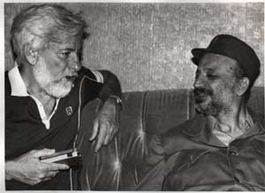
By the 1970s, Avnery believed that Zionism, which focused on Jews moving to Israel, was no longer as active. In 1975, he helped start the Israeli Council for Israeli–Palestinian Peace. Soon after, Avnery was attacked and injured.
He famously crossed the front lines to meet Yasser Arafat on July 3, 1982. This happened during the Siege of Beirut. It was believed to be the first time an Israeli met Arafat in person. An Israeli intelligence team was tracking Avnery. They planned to kill Arafat, even if it meant killing Avnery too. But the operation failed.
Robert Fisk interviewed Avnery when the Sabra and Shatila massacre happened. He asked Avnery how people who survived the Holocaust could watch 1,700 Palestinians be killed.
His meeting with Arafat caused problems with his mother. She did not speak Hebrew and only read a German newsletter. She disinherited him, meaning she did not leave him money in her will. She wrote that he visited "that murderer Yasser Arafat" instead of taking care of her. However, his sister gave him his share of the inheritance.
He later became a left-wing peace activist. He founded the Gush Shalom movement in 1993. He believed that every Israeli settlement made peace harder to achieve. He was also a secularist, meaning he believed in separating religion from government. He strongly opposed the influence of Orthodox Judaism in politics.
In 2001, Avnery and his wife Rachel received the Right Livelihood Award. They were honored "for their unwavering conviction... that peace can only be achieved through justice and reconciliation." In 2006, a settler activist called for the Israeli military to carry out a "targeted killing" against Avnery.
He supported talking with Hamas. In 2007, Gush Shalom printed stickers that said: "Talk to Hamas." Avnery himself once spoke to an audience of 500 religious leaders in Gaza in 1993. They listened to him speak in Hebrew and invited him to lunch.
Uri Avnery's Later Years
Avnery wrote articles for news websites like CounterPunch.
In April 2018, Avnery wrote an article criticizing the Israeli military. He wrote about their response to the 2018 Gaza border protests. He stated he did not support the soldiers who shot unarmed protesters.
On August 4, 2018, Avnery had a stroke. He was taken to the hospital in Tel Aviv in serious condition. He died at Ichilov Hospital on August 20, 2018, at age 94. This was less than a month before his 95th birthday.
He wished to be cremated. His ashes were scattered off the coast of Tel Aviv.
Uri Avnery's Personal Life
Avnery lived with his partner, Rachel Greenboim, for 58 years. They were together for five years before they married. In 1995, he said they were the only Israeli couple he knew who had not divorced. They met when she was 14, in 1946.
They met again around 1951. Rachel took care of him when he had his fingers broken. They lived together for five years. They did not want a religious marriage. In Israel, civil marriages are not permitted. So, they formalized their relationship privately with a rabbi. This was to ease Rachel's father's mind when he was ill.
Avnery said Rachel was very empathetic. He shared a story about watching a film with her. At the end, Menachem Begin was sitting in front of them. He stood up, crying, and kissed Rachel's forehead. Yasser Arafat also kissed her forehead when she and Avnery acted as human shields for him. Rachel earned the respect of Raed Salah during protests in 1992. She was a primary school teacher for 28 years.
Rachel died in May 2011. She suffered from a long-term illness. They chose not to have children.
Avnery had both diabetes and Crohn's disease. In his will, he left his money and assets to the people of Israel. This was to fund future peace projects.
Images for kids
See also
 In Spanish: Uri Avnery para niños
In Spanish: Uri Avnery para niños


